New DiscoveriesAnthon van Rappard, Three Brushmakers and a Bookkeeper in the Institute for the Blind in Utrecht, 1891
by Petra ten-Doesschate Chu
Petra ten-Doesschate Chu
Seton Hall University, South Orange, NJ
Email the author: Petra.Chu[at]shu.edu
Citation: Petra ten-Doesschate Chu, “Anthon van Rappard, Three Brushmakers and a Bookkeeper in the Institute for the Blind in Utrecht, 1891,” Nineteenth-Century Art Worldwide 21, no. 3 (Autumn 2022), https://doi.org/10.29411/ncaw.2022.21.3.6.
This work is licensed under a Creative Commons Attribution-NonCommercial 4.0 International License  unless otherwise noted.
unless otherwise noted.
Your browser will either open the file, download it to a folder, or display a dialog with options.
The 1884 Guide and Travel Book for the City and Province of Utrecht (Gids en reisboek voor de stad en de provincie Utrecht) strongly recommends a visit to the Work Institute for the Blind (Werkinrichting voor blinden), located on De Neude, a square in the center of the city:[1] “It is a moving sight to see the blind at work, a rich source of learning for the many who have every reason to be grateful yet are discontented with their lot.”[2] Readers are informed that the institute is open daily to visitors, except on Saturdays (when the blind submit the work they have produced during the week), Sundays, and holidays. Here is part of the guide’s description:
This institute . . . one of the outstanding institutions on which [the city of] Utrecht prides itself, is the result of voluntary donations and opened its door on October 22, 1864. Its purpose is to teach blind people to work and in so doing to ensure that they can make a living, as well as to sell what the blind have made. No one enters the institute without a certificate of blindness, supplied by the doctors of the Netherlands Hospital for Eye Patients in Utrecht as well as a certificate of moral behavior, supplied by the head of his community.[3]
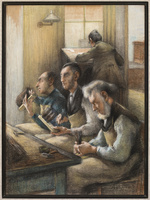
The Dutch artist Anthon van Rappard (1858–92), best known as a friend and correspondent of Vincent van Gogh (1853–90) during the first half of the 1880s, on two occasions spent time sketching in the Utrecht institute, first in the fall of 1882, then again sometime in 1890–91. Three Brushmakers and a Bookkeeper in the Institute for the Blind in Utrecht (fig. 1), the pastel discussed in this article, comes from the second sketching campaign and is dated 1891. It shows three men making brushes by fitting tight tufts of plant fibers into rectangular pieces of wood with holes drilled into them at regular intervals. A roll of thin metal wire and two hammers are seen on a table in front of them, placed diagonally to the picture plane. All three men seem to concentrate on their tasks, and, until one notices that they have their eyes closed or nearly so, it seems like a common scene of work. Behind the brushmakers, his back turned toward them and the viewer, is a fourth man, who is reading or writing at a tall desk. Bespectacled and wearing a faded black frock coat, he is commonly identified as a bookkeeper. In his 1895 doctoral dissertation on workhouses for the needy, H. W. Methorst, writing about the Utrecht Institute for the Blind (which by then had moved from De Neude to a different address), informs his readers that “the governing board [of the workhouse] comprises 9 gentlemen, including one salaried director, residing in the house, as the only employee charged with the daily supervision and management.”[4] To avoid complicating matters, I will continue to refer to the fourth man as the bookkeeper, though in all likelihood his function was broader than that.
After briefly outlining the arc of Van Rappard’s career, I will discuss the place of Three Brushmakers and a Bookkeeper in the Institute for the Blind in Utrecht (henceforth Three Brushmakers) within a substantial group of works by Van Rappard that represent the same scene or individual figures in it. In addition, considering the pastel against the foil of the oral and written exchanges about art between Van Rappard and Van Gogh (insofar as we can reconstruct them from the latter’s letters), I will suggest some ways in which these exchanges may have had an impact on both the subject and the form of this work. Before doing so, and in the interest of full disclosure, I must confess that, strictly speaking, Three Brushmakers is not a “new discovery.” It is mentioned and reproduced, in black and white, in the 1974 publication by Jaap W. Brouwer, Jan Laurens Siesling, and Jacques Vis, Anthon van Rappard, Companion and Correspondent of Vincent van Gogh, His Life and All His Works.[5] But already at the time of its publication, the pastel was difficult to access, as it was not in a public collection. Acquired some time ago by Gallery 19C in Beverly Hills, California, it is currently one of the few works by Van Rappard that can be seen in the United States. Coincidentally, another drawing by the artist, representing four matmakers, made around the same time and in the same Institute for the Blind in Utrecht, was acquired in 2020 by the Museum of Fine Arts in Boston.[6]
Born in Zeist, a village located some six miles from Utrecht, Anthon Gerard Alexander van Rappard attended high school in Utrecht before enrolling in the Rijksacademie (National Academy) of Amsterdam in 1876.[7] Cutting short his study program in the spring of 1879, he traveled to Paris in the fall to study for six months with Jean-Léon Gérôme (1824–1904). After spending the summer of 1880 in the Netherlands, Van Rappard, in the fall, enrolled for one semester at the Brussels Academy. His arrival in the Belgian capital roughly coincided with that of Vincent van Gogh, who, on the advice of his brother Theo (who had met Van Rappard in Paris), visited him at the end of October 1880. Though the two aspiring artists did not immediately bond—they were quite different in temperament and social background[8]—they soon formed a close friendship, which lasted for almost five years until they had what Van Rappard would later call a regrettable “misunderstanding.”[9] But between 1880 and 1884, Van Rappard visited Van Gogh six times—twice in Etten, twice in The Hague, and twice in Nuenen—and Van Gogh visited Van Rappard in Utrecht on two occasions. In addition, they exchanged numerous letters. Those by Van Gogh seem to have been largely preserved (fifty-eight are extant today); the letters by Van Rappard, with one exception, are lost. Soon after their falling-out, Van Gogh moved to Antwerp and then to France. Van Rappard returned to the Amsterdam Academy (October 1886–May 1888) before marrying in March 1889 and moving to Santpoort, near Haarlem, where he died three years later at age thirty-three.
The pastel of the Three Brushmakers was produced in 1891, one year before Van Rappard’s death and one year after the suicide or murder of Van Gogh.[10] Eight years earlier, on a day-long visit to Utrecht in May 1883, the latter had seen and admired some drawings Van Rappard had made during his first sketching session at the Institute of the Blind in the fall of 1882 (fig. 2). In a letter written immediately after his visit, Van Gogh had complimented his friend on the “heads of the blind men,” referring to pencil studies of blind old men Van Rappard had made there (fig. 3).[11] In a second letter, written a month later on November 17 or 18, he encouraged Van Rappard to stick with the subject of the Institute of the Blind rather than occupying himself with the frivolous task of designing menus and decorations for the seventy-fifth anniversary of the Utrecht art society Kunstliefde, of which Van Rappard was an active member:[12]
Well, now you mustn’t take it the wrong way if I repeat in somewhat stronger terms what I mean. The more menus and decorations for festive occasions you make, even if they’re pleasing and good, the less you’ll be able to remain in agreement with your artistic conscience. The more you stay with the serious toil of institute for the blind, tile painters, knitters &c., the more you’ll feel that such toil has its raison d’être, even if one has no immediate success.[13]

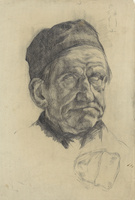
Though Van Rappard went back to drawing and painting tile painters as well as other workers, such as silversmiths, brick makers, spinners, and knitters, he did not return to the Institute of the Blind until around 1890, when he made numerous studies in different media that culminated in 1891 in a substantial oil painting measuring 160 x 126 cm (63 x 50 in.). The whereabouts of that painting, unfortunately, are unknown (it was last seen at an exhibition in Utrecht in 1931),[14] but numerous works related to it exist. In their 1974 catalogue raisonné of Van Rappard’s work, Brouwer, Siesling, and Vis list, besides the pastel discussed here, two oil studies of the bookkeeper, a pencil drawing for the entire composition (fig. 4), and seven full-length, half-length, or head studies in pencil and/or chalk for individual figures (fig. 5).[15] Since then, additional oil sketches for the heads of two of the blind men as well as a watercolor study have surfaced.[16] This elaborate preparation may be attributed to Van Rappard’s academic training at the Amsterdam Academy, in the studio of Gerôme, and at the Brussels Academy, where he would have learned the importance of proceeding from life studies in chalk or pencil on paper to compositional sketches in pencil, pastel, or oil; then to oil studies for the most important figures, and finally to the finished painting. Yet, the seeming “over-preparation” of the final canvas may also be linked to a sense of insecurity and self-doubt. Van Rappard’s friend, the critic Johan de Meester (1860–31), said at the opening of the artist’s retrospective exhibition in 1931: “All his work was born in pain. Hardly ever was he satisfied or pleased with it.”[17]
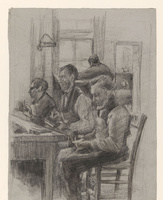
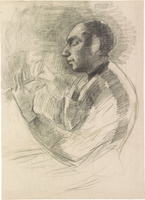
By the time of Van Rappard’s second sketching campaign in the Utrecht Institute for the Blind, his friendship with Van Gogh had been over for more than five years.[18] Nonetheless, the works resulting from this campaign clearly bear the stamp of the discussions they had had about art, both in person and in writing. As mentioned earlier, what we know about these discussions is strictly confined to Van Gogh’s letters, as the letters from Van Rappard to Van Gogh, with one exception, have not been preserved. Nonetheless, we can form a clear idea of several issues that preoccupied the two artists. Much of the content of the letters was related to their shared interest in contemporary wood-engraved illustrations found in such magazines as The Graphic, Harper’s Weekly, The Illustrated London News, and L’Illustration during the second half of the nineteenth century. Both artists collected these wood engravings and exchanged duplicates.[19] Not only were they by far the dominant topic of Van Gogh’s letters to Van Rappard but they also appear to have been an important reason for their mutual visits. In his letters, Van Gogh repeatedly invited Van Rappard to come to Etten, Nuenen, or The Hague, respectively, not only to see his own work but also the prints in his collection. Conversely, Van Gogh admired Van Rappard’s prints during his visits to Utrecht. Both artists were aware that, in the judgment of most of their contemporaries, the “illustrative” character of these wood engravings placed them outside the canon of “high” art,[20] but Van Gogh vehemently defended the art form and held it up as the model for his own art:
Yes, I’m so taken by all of it [contemporary wood engravings] that my whole life is aimed at making the things from everyday life that Dickens describes and these artists [those who worked for illustrated magazines] draw.[21]
While covering a wide variety of subjects, an important subset of nineteenth-century magazine illustrations was devoted to the domestic, work, street, and institutional lives of the working class and the poor. Factories, workshops, workhouses, soup kitchens, old-age homes, and other charitable institutions were a common subject, especially in England. Such topics allowed artists to create multifigure compositions with a variety of popular types set in environments where many viewers felt they naturally belonged. Intended for a middle-class public, these prints and related paintings ranged from the documentary and journalistic to the sentimental and socially engaged.
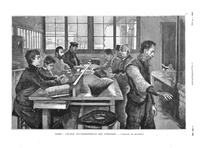
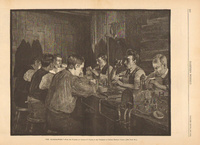
Van Rappard’s Three Brushmakers fits within this category of subjects. Blind people were a relatively common theme in nineteenth-century art, generally represented as homeless and on the road like John Everett Millais’s (1829–96) The Blind Girl of 1856 (Birmingham Museum and Art Gallery) or Fred Walker’s (1840–75) The Wayfarers of 1863, an etching widely available at the time (through originals, copies, and reproductions) that Van Gogh admired;[22] or as institutionalized in schools (mostly for children born blind) and other institutions (for older blind people); or as practicing simple trades like brushmaking, basket or mat weaving, and chair caning. Van Rappard’s pastel and related oil painting have been compared with an 1884 image in L’Illustration of the brushmaking workshop in the Parisian Professional School for the Blind (École professionelle des aveugles) (fig. 6), but the similarity is only in the subject.[23] Formally, they have more in common with a wood engraving of glassblowers after a painting by the German-American artist Charles F. Ulrich (1858–1908) in Harper’s Weekly (fig. 7), which was in Van Gogh’s collection and perhaps in Van Rappard’s as well.[24] The right three figures in this print, like Van Rappard’s brushmakers, are seated at a table placed diagonally to the picture plane and are spaced and arranged in a similar way. The comparison with Ulrich’s print makes one realize that, though the title of Van Rappard’s pastel causes the viewer to focus on the blindness of the brushmakers, that aspect, in some way, is incidental to its content, which is primarily focused on the action of making brushes—bunching the fibers into tufts; tying them together with metal wire (perhaps using the hammer to tighten the wire’s grip), and stuffing the tufts into the drilled plank. While in the print in L’Illustration the theme of blindness is emphasized by the dramatically foreshortened, groping arm of the blind man in the right foreground, in Van Rappard’s pastel it is suggested in the first instance by the closed eyes. Two of the men have their heads inclined and seem “focused” on their work. Only the man in the middle holds his head up high (like the central glassblower in Ulrich’s print). Van Rappard has “normalized” the blind rather than drawing attention to their disability. This pastel has neither the pathos of such works as Walker’s The Wayfarers or even Van Rappard’s own earlier drawing of a blind man (fig. 3); nor does it appear to teach the moral lesson of being content with one’s lot that the Utrecht travel guide would have liked visitors to the Institute of the Blind to take home. In his letters Van Gogh often criticized Van Rappard for his emphasis on technique at the expense of “character” and “power of expression.”[25] One wonders whether this pastel would have elicited such a reproach.
It is worth remembering that at the height of his friendship with Van Rappard, Van Gogh was working on his Potato Eaters of 1885 (Amsterdam, Van Gogh Museum). Writing to his brother Theo about this painting, he claimed that it had “taken [him] a whole winter of painting studies of heads and hands.” This lengthy preparation process had allowed him to capture the “character” of the scene. He felt that he had made something “genuine and honest” that would give the middle-class viewers of the painting “something to think about.”[26] To Van Gogh, the latter could not be done through technical perfection but required a willingness to depart from it for the sake of expression. As he wrote to Theo, “what I’m trying to get with it is to be able to draw not a hand but THE GESTURE, not a mathematically correct head but the overall expression. . . . Life, in short.”[27]
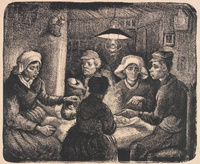
And this is where Van Rappard and Van Gogh parted ways. When Van Gogh sent him a lithograph he had made after the Potato Eaters (fig. 8), a work that he wanted to speak of “MANUAL LABOUR and—that they have thus honestly earned their food,”[28] Van Rappard criticized it harshly:
You’ll agree with me that such work isn’t intended seriously.
You can do better than this—fortunately; but why, then, observe and treat everything so superficially? Why not study the movements? Now they’re posing. That coquettish little hand of that woman at the back, how untrue! And what connection is there between the coffeepot, the table and the hand lying on top of the handle? What’s that pot doing, for that matter; it isn’t standing, it isn’t being held, but what then? And why may that man on the right not have a knee or a belly or lungs? Or are they in his back? And why must his arm be a meter too short? And why must he lack half of his nose? And why must the woman on the left have a sort of little pipe stem with a cube on it for a nose?
And with such a manner of working you dare to invoke the names of Millet and Breton? Come on! Art is too important, it seems to me, to be treated so cavalierly.[29]
Offended, Van Gogh returned the letter to Van Rappard, and their friendship, essentially, was over. But this does not mean that Van Gogh was not touched by Van Rappard’s ideas and—more importantly for this article—vice-versa. Comparing the pastel of Three Brushmakers and a Bookkeeper in the Institute for the Blind in Utrecht with the preliminary compositional drawing (fig. 4), it is easy to see how the artist departed from objective documentation to create a work that is at once more artful and more expressive than its model: the scene is more closely cropped so that the figures seem nearer to the viewer. The facial features—the nose of the brushmaker to the left, the shock of white hair and beard of the one on the right—are more accentuated. The three brushmakers have been pushed closer together and the bookkeeper has been brought up higher, so we see more of the black frock coat that distinguishes him from the workers in their white shirts and vests or blue jacket. Though the changes are subtle and never surpass the limits of verisimilitude, perhaps, after all, Van Rappard was aiming at giving the viewers of Three Brushmakers something to think about—what it meant to be at once blind and invisible, tucked away in an “institution” away from public view; what it meant to be reliant, materially, on the charity of others and, physically, on one’s sense of touch; or, perhaps, on the positive side, what it meant to conquer a disability by learning a trade and becoming a contributing member of society. Carefully balancing documentary objectivity and artistic subjectivity, Van Rappard ultimately created an elusive image open to interpretation: three blind brushmakers at once dependent and limited to simple work yet also capable, competent, and confident in that work; three blind brushmakers, segregated in an institute but one that is recommended in travel guides as a place worth visiting for the positive example offered by its inmates; three blind brushmakers and a bookkeeper, at first glance “characters” in a late nineteenth-century Dickensian scene, but on closer view, individual persons, with names, personalities, and unique life trajectories.
In a letter written in 1882, Van Gogh mocked Van Rappard for his remark that “one should only send something into the world when that something meets strict technical standards.” He compared Van Rappard’s approach with that of a person who never leaves the house before dressing up and looking in the mirror. He himself, as he wrote to Van Rappard, thought it was better, “in the midst of a campaign, . . . to march quickly [rather] than to make . . . one’s toilet.”[30] Though we don’t have Van Rappard’s retort to his friend’s remark, this pastel suggests that he preferred to wage nuanced rather than brazen campaigns, allowing for careful preparation and grooming and a final look in the mirror.
Postscript
When I first saw it on Gallery 19C’s website, Van Rappard’s pastel of Three Brushmakers struck me not only for its artistic merits but also because I felt a personal connection to it. Like Van Rappard, I was born in Zeist, where my father was an ophthalmologist. He later became the director of the Dutch Hospital for Eye Patients in Utrecht, to which the Institute of the Blind was initially connected. Before it was acquired by Gallery 19C, Van Rappard’s pastel hung in The Finspong, a former institute for the blind in Zeist. When I was a child, my father made regular visits there. Did he see Van Rappard’s pastel? If he did, he could hardly have foreseen that both the pastel and his daughter would one day cross the Atlantic Ocean to be serendipitously connected.
Notes
All translations are by the author unless otherwise indicated.
[1] Justus Wilhelmus Robertus Gerlach, Gids en reisboek voor de stad en de provincie Utrecht (Utrecht: Stoom Snelpersdruk van de Firma L. E. Bosch & Zoom, 1884), 58. Hereafter I will shorten “Work Institute for the Blind” to “Institute for the Blind.”
[2] “Een bezoek aan deze werkinrichting wordt zeer aanbevolen. Het is een aandoenlijk schouwspel de blinden aan het werk te zien.” Gerlach, Gids en reisboek, 58. The institute was the creation of the Association for the Support and Moral Development of Needy Blind People in Utrecht (Vereeniging tot de ondersteuning en zedelijke ontwikkeling van hulpbehoevende blinden te Utrecht), founded October 22, 1864. It was originally located in the Begijnestraat, next to the first building of the Netherlands Hospital for Deprived and Indigent Eye Patients (Nederlands gasthuis voor behoeftige and minvermogende ooglijders). It subsequently moved to several different addresses until, by the 1880s, it was located on De Neude. Sometime in the 1890s it moved to Achter St. Pieter, no. 10. See H. Smissaert, Armenzorg in Nederland. De Gemeente Utrecht (Amsterdam: Müller, 1899), 262.
[3] “Deze inrichting, die [. . .] een der voortreffelijkste instellingen is, waarop Utrecht bogen kan, kwam uit vrijwillige bijdragen tot stand en werd den 22 October 1864 geopend. Zij dient om blinden te leeren werken en hun daardoor een middel van bestaan te verzekeren, en tevens, om hetgeen door de blinden vervaardigd is te verkopen. Niemand wordt in de inrichting opgenomen, dan met bewijs dat hij blind is, afgegeven door heeren doctoren van het Ned. gasthuis voor ooglijders te Utrecht en een bewijs van zedelijk bedrag, afgegeven door het hoofd zijner gemeente.” Gerlach, Gids en reisboek, 58.
[4] “Het bestuur bestaat uit 9 heeren, onder wie een bezoldigd directeur, wonende in ’t huis, als eenige ambtenaar met het dagelijksch toezicht en de leiding belast.” Cited in Smissaert, Armenzorg, 262. The Utrecht Institute for the Blind fits perfectly in the historiography of approaches to disability in the Netherlands. As Luc Brants, Paul van Trigt, and Alice Schippers have pointed out, deaf and blind people were “virtually the only groups with a bodily impairment who were subject to public interest in the nineteenth century.” The dominant approaches to the deaf and blind were education, with the goal of making them “useful” citizens, and segregation. Most schools and institutes were private and charitable; many, though not all, were run by religious groups. See Brants, Van Trigt, and Schippers, “A Short History of Approaches to Disability in the Netherlands,” in The Routledge History of Disability, ed. Roy Hanes, Ivan Brown, and Nancy E. Hansen (London and New York: Routledge, 2017), ch. 9, 153–54.
[5] Jaap W. Brouwer, Jan Laurens Siesling, and Jacques Vis, Anthon van Rappard, Companion and Correspondent of Vincent van Gogh, His Life and All His Works (Amsterdam: Arbeiderspers; Maarssen, the Netherlands: Gary Schwartz, 1974), 106, no. 178.
[6] For a reproduction of this unpublished drawing, see https://collections.mfa.org/. The drawing is similar to two other drawings of the same subject in the Museum Boijmans Van Beuningen in Rotterdam and the Rijksprentenkabinet in Amsterdam, respectively. See Brouwer, Siesling, and Vis, Anthon van Rappard, 108, nos. 184 and 185.
[7] For a more in-depth biographical sketch of Van Rappard, see Brouwer, Siesling, and Vis, Anthon van Rappard, 15–27.
[8] Van Rappard belonged to the Dutch nobility, carrying the title of ridder (knight). Although Dutch aristocratic titles had not been associated with legal privileges since 1848, they did lend their bearers a certain social prestige.
[9] “een misverstand dat ik dikwijls betreurd heb.” Condolence letter from Van Rappard to Van Gogh’s mother, cited in Johanna Gesina van Gogh-Bonger, Vincent van Gogh: Brieven aan zijn broeder, vol. 1 (Amsterdam: Mij. voor goede and goedkoope lectuur, 1914), 33. The “misunderstanding” was caused by a letter Van Rappard sent to Van Gogh sharply criticizing the latter’s lithograph after The Potato Eaters (see note 28, below). For more on the friendship between Van Gogh and Van Rappard, see Brouwer, Siesling, and Vis, Anthon van Rappard, 29–39.
[10] On the mystery surrounding Van Gogh’s death, see Steven Naifeh and Gregory White Smith, Van Gogh: The Life (New York: Random House, 2011), 851–61.
[11] See Leo Jansen, Hans Luijten, and Nienke Bakker, eds., Vincent van Gogh: The Letters (Amsterdam: Van Gogh Museum/Huygens ING, 2009), letter no. 345, https://vangoghletters.org/vg. Henceforth this source will be referred to as Van Gogh Letters.
[12] Kunstliefde (Love of Art) was an old and respected artists’ society in Utrecht. Van Rappard had joined it in 1880 and for some years was heavily involved in its activities.
[13] Van Gogh Letters, no. 284.
[14] A. G. A. Ridder Van Rappard: Tentoonstelling van zijn werken (Utrecht: Voor de Kunst, 1931), cat. no. 4. The painting is reproduced in Brouwer, Siesling, and Vis, Anthon van Rappard, cat. no. 177.
[15] Brouwer, Siesling, and Vis, Anthon van Rappard, 106–7, cat. nos. 169–81.
[16] An oil sketch for the head of the brushmaker on the left was auctioned at Sotheby’s, Amsterdam, on October 17, 2006 (19th Century European Paintings, auction cat. [Amsterdam: Sotheby’s, 2006], lot 131). Another oil sketch, for the head of the brushmaker on the right, was sold on November 23, 2014, via the Catawiki website (lot no. 987671), https://www.catawiki.com/. According to Catawiki’s metadata, this study was once owned by the model’s family. A watercolor for the bookkeeper, signed and dated 1891, was auctioned at the Zeeuws Veilinghuis in Middelburg, Netherlands, on June 5–6, 2018 (lot no. 407) (no catalogue was published for this sale). A tracing in pen on paper of the bookkeeper, for some reason not mentioned in Brouwer, Siesling, and Vis, Anthon van Rappard, has been in the Centraal Museum in Utrecht since 1935 (inv. no. 7635/017). Though I presume that the drawings, the oil sketches, and the pastel were all preparatory studies for the finished painting, it is, of course, possible that some were made after completion of the oil painting. The numerous versions in different media of the bookkeeper—an oil on canvas, an oil on panel, a watercolor, a pen drawing, and a contour drawing, point to Van Rappard’s interest in experimenting with different media and techniques.
[17] Cited in Brouwer, Siesling, and Vis, Anthon van Rappard, 27.
[18] It is possible that Van Gogh had already died. There is some uncertainty about the exact dates of Van Rappard’s second sketching campaign in the Institute for the Blind in Utrecht. With one exception (Brouwer, Siesling, and Vis, Anthon van Rappard, 105, no. 171, dated 1890), the few works that are dated bear the date of 1891.
[19] On Van Rappard’s interest in wood engravings, see Brouwer, Siesling, and Vis, Anthon van Rappard, 40–50. On Van Gogh’s interest in the same, see, among others, Martin Bailey and Debora Silverman, Van Gogh: Portrait of the Artist as a Young Man in England, exh. cat. (London: Barbican Gallery, 1992), 73–83; and Naifeh and Smith, Van Gogh: The Life, 310–23.
[20] Van Gogh Letters, no. 263.
[21] Van Gogh Letters, no. 267.
[22] He expressed his admiration in a letter to Van Rappard. See Van Gogh Letters, no. 232.
[23] Brouwer, Siesling, and Vis, Anthon van Rappard, 49–50.
[24] The wood engraving in Harper’s Weekly was a reproduction of Ulrich’s 1883 painting, now in the Museo de Arte de Ponce, Puerto Rico.
[25] See Van Gogh Letters, nos. 284 and 439.
[26] Van Gogh Letters, no. 497.
[27] Van Gogh Letters, no. 502. Emphases in the original.
[28] Letter from Vincent van Gogh to Theo van Gogh, April 30, 1885, in Van Gogh Letters, no. 497. Emphases in the original.
[29] Van Gogh Letters no. 503. Emphasis in the original. Van Gogh returned the letter to Van Rappard. Though the two artists subsequently exchanged more letters, the damage to the friendship was irreparable.
[30] Van Gogh Letters, no. 284.